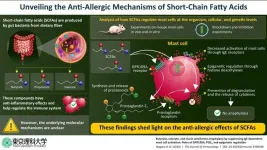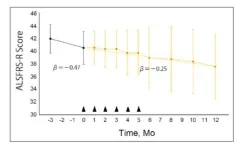The intricate relationship that exists between humans and the gut microbiome has become a hot research topic, and scientists are constantly uncovering new reasons why a healthy diet can lead to a healthier life. Dietary fibers are a particularly important aspect of this connection. When we ingest these compounds, which are mainly found in plant-based foods, our gut bacteria break them down into small molecules, called short-chain fatty acids (SCFAs). Over the past few years, studies have revealed various important anti-inflammatory and immunomodulating effects of SCFAs.
One of the ways SCFAs interact with our immune system is by mediating the activation of mast cells (MCs). These white blood cells are loaded with small sacs called “granules,” which are full of enzymes and signaling molecules like histamine. When an MC detects an antigen (foreign body), it becomes active and undergoes degranulation, releasing these substances to nearby tissue and triggering a fast immune response. Usually, MCs play a central role in allergic diseases, including pollinosis and severe food allergies. While there is considerable evidence that SCFAs have anti-allergic properties, the precise mechanisms by which they regulate the function of MCs remain unclear.
In a recent study, a research team led by Professor Chiharu Nishiyama from Tokyo University of Science, Japan, decided to address this knowledge gap through extensive experiments on mouse MCs and SCFAs. Their findings were published in The Journal of Immunology on January 10, 2024.
The researchers initially found that feeding mice with butyric acid and valeric acid, two representative SCFAs, significantly suppressed passive cutaneous anaphylaxis (a type of well-studied allergic reaction induced artificially in laboratory settings). Using MC cultures, the team then showed that treating MCs with various SCFAs suppressed Immunoglobulin E (IgE)-mediated activation, a crucial pathway in allergic reactions.
Through subsequent experiments involving genetically modified cells and precise RNA inhibitors, they managed to further piece together the puzzle. The researchers found that SCFAs mediated MC activation in mainly two ways. The first was through the recognition and interaction with the GPR109A receptor. Upon binding with SCFA, a chemical cascade ensues, culminating with the synthesis and secretion of prostaglandins. These substances interact with EP3 receptors in MCs and prevent degranulation, limiting the release of histamine and minimizing allergic response.
The second was through epigenetics (or reversibly altering specific genes). The researchers confirmed that SCFAs affected histone deacetylase inhibitory activity, which regulates epigenetic modifications. This led to changes in the expression levels of the IgE-receptor, which ultimately inhibited degranulation in MCs. Additional experiments revealed that non-steroidal anti-inflammatory drugs suppressed the anti-allergic effects of SCFAs, and that vitamin B-3, which interacts with the GPR109A receptor, also inhibited MC degranulation.
Together, the findings of this study can help scientists navigate the intricacies of how our bodies regulate our immune system with the help of gut bacteria. However, people with allergies stand to gain from these insights, as Prof. Nishiyama points out: “The activation of mast cell is a common cause of various allergic diseases and not limited to anaphylaxis. In addition, I think that the increasing frequency of allergic patients is associated with changes in diet in these decades. Allergies are so common that one in two Japanese people is said to have some kind of allergic disease, and the results of our study showcase dietary fibers as an effective way of treating them.” Considering that about 200,000 visits to the emergency room per year are due to anaphylaxis in the United States alone, this work could not only save lives from by preventing this dangerous condition, but also help ameliorate the burden on healthcare systems.
Satisfied with the results, Prof. Nishiyama concludes by noting the importance of eating well. “It is important to demonstrate with scientific evidence how dietary conditions affect health,” she says. “This research has revealed part of the complex regulatory mechanisms involving various food-related components, including dietary fiber, SCFAs, polyunsaturated fatty acids, and vitamins.”
Notably, Prof. Nishiyama and her colleagues now intend to investigate the relationship between the mucosal environment and immunoregulation by focusing on specific SCFAs, which may lead to the uncovering of the health benefits of various foods soon.
With any luck, their efforts will lead to better dietary decisions and healthier lives!
***
Reference
DOI: https://doi.org/10.4049/jimmunol.2300188
Authors: Kazuki Nagata1, Daisuke Ando1, Tsubasa Ashikari1, Kandai Ito1, Ryosuke Miura1, Izumi Fujigaki1, Yuki Goto1, Miki Ando1, Naoto Ito1, Hibiki Kawazoe1, Yuki Iizuka1, Mariko Inoue1, Takuya Yashiro1, Masakazu Hachisu1, Kazumi Kasakura1, and Chiharu Nishiyama1
Affiliations:
1Department of Biological Science and Technology, Faculty of Advanced Engineering, Tokyo University of Science
About The Tokyo University of Science
Tokyo University of Science (TUS) is a well-known and respected university, and the largest science-specialized private research university in Japan, with four campuses in central Tokyo and its suburbs and in Hokkaido. Established in 1881, the university has continually contributed to Japan's development in science through inculcating the love for science in researchers, technicians, and educators.
With a mission of “Creating science and technology for the harmonious development of nature, human beings, and society," TUS has undertaken a wide range of research from basic to applied science. TUS has embraced a multidisciplinary approach to research and undertaken intensive study in some of today's most vital fields. TUS is a meritocracy where the best in science is recognized and nurtured. It is the only private university in Japan that has produced a Nobel Prize winner and the only private university in Asia to produce Nobel Prize winners within the natural sciences field.
Website: https://www.tus.ac.jp/en/mediarelations/
About Professor Chiharu Nishiyama from Tokyo University of Science
Dr. Chiharu Nishiyama is a Professor at the Faculty of Advanced Engineering, Department of Biological Science and Technology. She received her postgraduate degree in 1990 from the Department of Agricultural Chemistry at University of Tokyo Graduate School, followed by a PhD from the University of Tokyo. Her areas of research interest include applied biochemistry, covering fields such as immunology, allergy, molecular biology, transcription factors, and cell development. She has published over 130 research papers in international journals. She also received the prestigious JSBBA Award for Young Scientists in 2005, JSA Award for Young Scientists in 2005, and JAFI Award in 2019.
END





